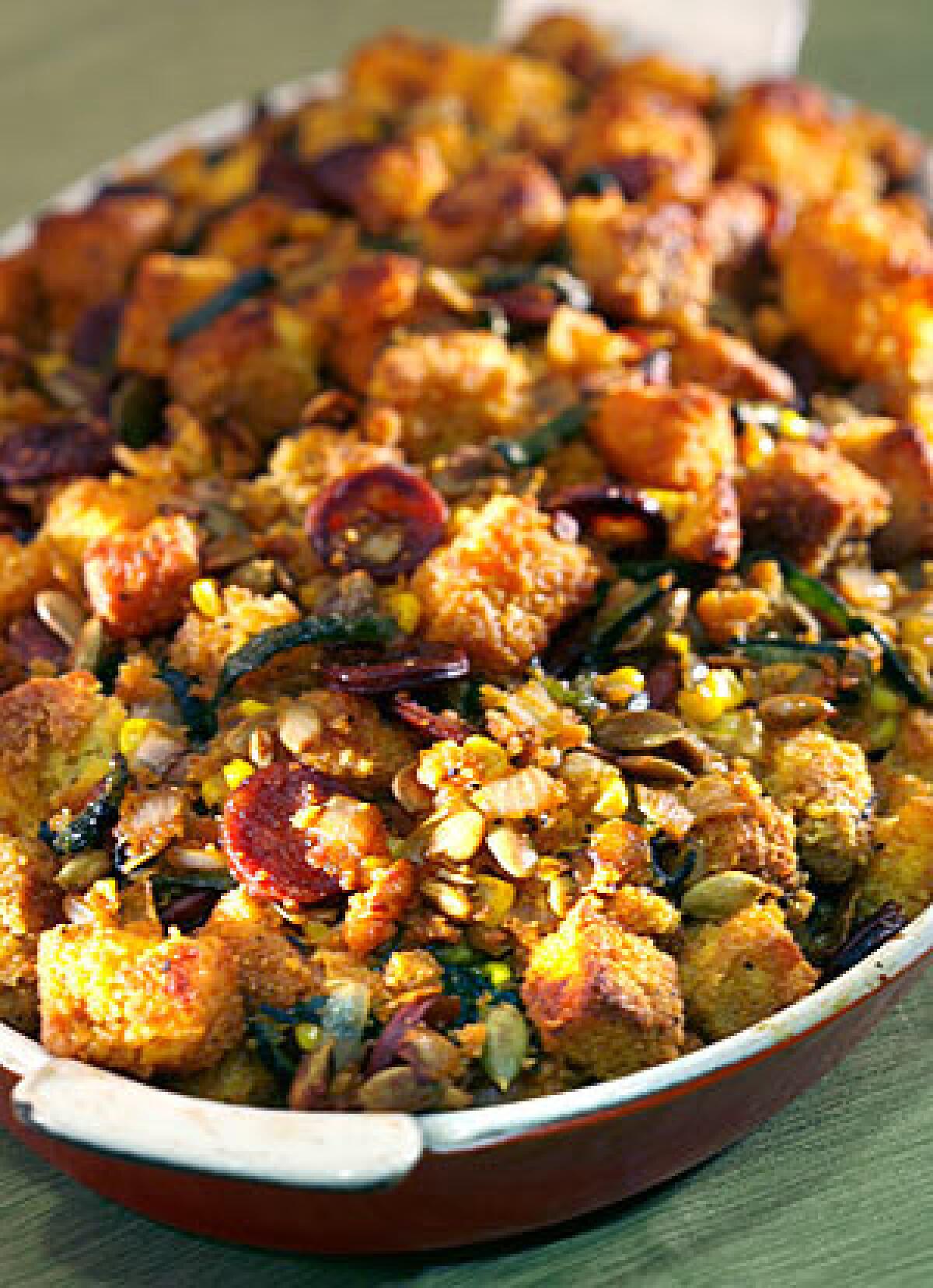Pumpkin is ripe for many a Thanksgiving Day dish

Of the many rituals that signify the holiday dinner, there are two that serve as the bookends that make Thanksgiving more than just another lowercase meal: the carving of the turkey to start the festivities and the serving of the pumpkin pie at the very, very end.
Now for turkey lovers, that order is fine. But for us pumpkin lovers, it’s a mighty long time to wait. Too long.
Rather than sit around like Linus waiting for the Great Pumpkin to appear, can’t we celebrate the squash throughout the meal?
Let’s step away from the pie crust and rethink pumpkin at Thanksgiving. It’s a versatile vegetable that can be used in many ways. Roast it whole or in pieces, sauté it as a side dish or simmer it slowly for soup. Bake it into breads and rolls both savory and sweet.
And the number of varieties available seems to increase with every season, as more and more heirloom cooking pumpkins show up at farmers markets and grocery stores, each with its own subtleties in color and flavor.
As for introducing the new uses for pumpkin at our Thanksgiving meal, a logical place to start is with a salad. Try adding roasted pumpkin to peppery greens for a contrast in texture and flavor. One is buttery and sweet; the other is crunchy and sharp. Together they play up each other’s best qualities.
Roasting is a simple way to cook squash, and it’s perfect for coaxing out the subtle flavors and rich, caramelized sweetness. Peel, clean and coarsely chop the pumpkin. Toss the pieces with red pearl onions, a little olive oil and a sprinkling of chopped rosemary and thyme. Roast at 350 degrees for just under an hour, tossing occasionally so the pieces cook evenly, until they are tender, caramelized and fragrant.
Cool until ready to serve -- the pumpkin can be made a day ahead and refrigerated. Just before serving, toss with a blend of frisée and mixed greens, and fold in crisp bacon and toasted walnuts.
And don’t forget to save those seeds -- they’re terrific toasted on their own, or use them to lend color and crunch to other dishes. They’re often also a good substitute for nuts when allergies are an issue. Peel and toast your own, or buy the seeds -- also known as pepitas -- whole or already shelled at the market.
Try adding the toasted seeds to stuffing, another staple of the Thanksgiving meal. Combine the seeds with toasted cubes of corn bread, sautéed Spanish chorizo and corn. Throw in a few roasted poblano chiles for a little heat, and season with oregano, cumin and Spanish smoked paprika. Toss the stuffing with melted butter and chicken broth, and then bake in the oven until the topping is crisp and golden and the contents are warmed through.
The selection of good-for-cooking pumpkin varieties now extends well beyond the old favorite, Sugar Pie. Reading a seed catalog or strolling through the produce section, you might find pumpkins such as the Long Island cheese squash, named because it resembles a massive round of cheddar and which is especially good for baking in pies, or the French Galeux d’Eysines, which may be better known for its warty shell, but it has a really fresh, vibrant flavor.
Off-the-shelf option
But you don’t need to have an heirloom pumpkin to cook these dishes. In fact, for many preparations, canned pumpkin purée works well. Made from a variety of pumpkin closer in looks to butternut squash, the purée can be used for soups, risottos, sauces, dressings and a number of baked goods in addition to pie.
Of course, making your own purée is simple. Halve the pumpkin crosswise, scraping out the seeds and pulp. Place the halves, cut-side-down, on a foil-lined baking tray and bake at 350 degrees for an hour or so until the flesh is tender (carefully lift one of the halves and test the flesh under the shell, it should spoon out easily).
Remove the pumpkin from the oven and cool slightly, then spoon the flesh out of the shell and purée until smooth. Push the purée through a strainer to remove any solids and store until needed. It’ll keep, refrigerated, for a week and will freeze up to three months.
One way to use the purée is in a fragrantly spiced pumpkin cake. Like bananas, pumpkins lend a moist texture and tender crumb to baked goods without adding fat.
While most pumpkin cakes are finished with a cream cheese- or lemon-based frosting, why not try a sour cream ganache? Chocolate and pumpkin are an unexpected pairing, but adding sour cream to the frosting gives a pleasantly light tang. Be sure to use a chocolate that isn’t too dark and bitter. This is one place where semisweet is an improvement.
Not to make that pumpkin pie jealous, but who knows? Now that you’ve gotten your pumpkin fix in other places, you might start noticing all those other pies on the table.
Carter is a Times staff writer.
More to Read
Sign up for The Wild
We’ll help you find the best places to hike, bike and run, as well as the perfect silent spots for meditation and yoga.
You may occasionally receive promotional content from the Los Angeles Times.











